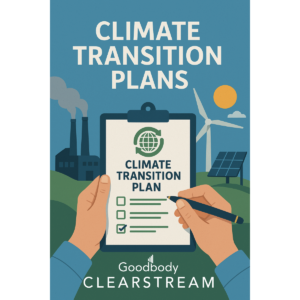 As climate change intensifies, businesses, governments, and financial institutions face growing pressure to adopt strong climate transition plans. These strategies are key to building a low-carbon, sustainable future and meeting global goals like the Paris Agreement.
As climate change intensifies, businesses, governments, and financial institutions face growing pressure to adopt strong climate transition plans. These strategies are key to building a low-carbon, sustainable future and meeting global goals like the Paris Agreement.
But what exactly constitutes a climate transition plan, and why is it so critical?
A climate transition plan is a structured roadmap that defines an organization’s goals, actions, and resources to address climate risks and reach net-zero emissions. Importantly, Climate Transition Plans (CTPs) are not merely repackaged net-zero strategies or decarbonization roadmaps; rather, they serve as holistic narratives detailing an organization’s strategic approach to sustainability. Given the lack of a universally agreed-upon definition, Goodbody Clearstream has drawn upon the frameworks established by the Climate Transition Plan (CTP) guidelines, the UK’s Transition Plan Taskforce (TPT), and the Corporate Sustainability Reporting Directive (CSRD) to define the key components of a credible CTP.
At the core of any CTP are robust metrics, defined targets, and a structured approach to decarbonization.
Establishing a baseline carbon footprint is a crucial first step. To begin with organizations should, at a minimum, quantify their Scope 1 and Scope 2 emissions. Additionally they should commit to evaluating their Scope 3 emissions. With a clear emissions profile in place, the next priority is setting science-based targets to guide decarbonization efforts.
Once targets are established, businesses must identify the most effective decarbonization pathways and initiatives. Decarbonization levers represent broad strategic approaches, such as energy efficiency improvements, electrification, fuel switching, or product modifications. In contrast, decarbonization actions refer to specific, implementable measures designed to achieve emissions reduction goals.
For example, if a company identifies fuel switching as a key decarbonization lever, a corresponding decarbonization action could involve transitioning from diesel to hydrotreated vegetable oil (HVO). Through this process, organizations develop a clear roadmap for achieving their carbon reduction targets.
However, a climate transition plan goes further than just setting targets and outlining actions.
It should also articulate how the business intends to navigate the broader economic transition to a low-carbon future. This involves assessing climate-related risks and opportunities, using scenario analysis to anticipate future climate conditions, and strategic planning to address emerging challenges. Furthermore , transparency in governance is essential, as stakeholders increasingly expect clear, executive-level commitment to sustainability goals.. High-level oversight and robust feedback mechanisms signal an intent to integrate climate goals into the broader corporate strategy.
Developing a climate transition plan is, first and foremost, a complex but necessary endeavour. Moreover, it requires d a high level of maturity in sustainability management. At its core, a CTP is a formalized report that documents the substantial efforts undertaken by a business to align with a low-carbon economy and society. However, this process is not without its challenges, including:
- Carbon Footprint Measurement – Ensuring an accurate and verified inventory of Scope 3 emissions remains a significant challenge.
- Target Setting – Selecting the most appropriate emissions reduction scenarios for both near- and long-term planning, with additional complexities related to the validation process for science-based targets.
- Risk Management – Identifying and preparing for long-term climate risks while developing credible mitigation strategies.

Nevertheless, despite these challenges, climate transition planning is becoming increasingly important aspect of corporate sustainability. CTPs are emerging as key performance indicators for green finance, influencing investor decision-making and regulatory compliance. As their significance continues to grow, organizations that proactively develop and implement credible transition plans will be better positioned to thrive in the evolving sustainability landscape.
If you wish to discuss your climate transition journey or how we can help your businesses, please contact Fionn at fionn@goodbodyclearstream.ie
